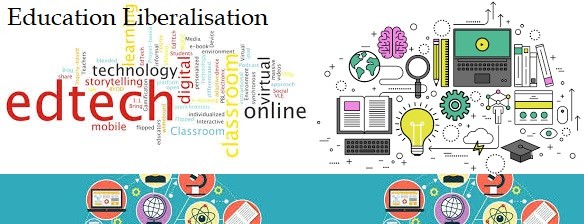
Education Liberalisation: Teacher Centric Approach and Edtech during Covid-19 and After
A new approach of educating and reaching students will help to make an eco-system for the digital education, which has become now mandatory in the Covid-19 lockdown period.
On the government level, India needs to have a better approach of educating and reaching students for teaching and evaluating them (learning process). It will help to make an eco-system for the digital education, which has become now mandatory in the Covid-19 lockdown period. As the experts are forecasting that people need to follow the precautions and social-physical distancing for a long run even after lifting the Covid-19 lockdown, digital education will also be a general norm even post Covid-19 and after. Here, as WTO is listing the efforts of various countries have taken in the education using edtech facilities, will not be enough, it needs a more contribution from the education/pedagogy experts irrespective of their affiliation-private or government. Technology is only a medium, basic thing is teaching methods and quality. There is a need of a complete overhaul/disruption in learning, assessment content and approach. We need to have a completely new approach of learning testing/evaluating to make the edtech supported education feasible, applicable and meaningful.
My implicit of liberalisation means that the centre of the whole process should be a teacher, instructor and students irrespective of government and private with variety of choices.
Teacher Centric Liberalisation of Education and Learning System
Above mentioned efforts will be foundation for the adaption of changes and sustainability of the new approach but only these efforts to be taken by governments will not be enough, especially in vast countries having scenario like India. We cannot equate the ways required to teach all the students in India. Geographical, infrastructural, lingual, economical levels vary region to region, state to state and people to people. My implicit of liberalisation means that the centre of the whole process should be a teacher, instructor and students irrespective of government and private with variety of choices. Thus, students will have choice to select the right edtech platform for them. A teacher/instructor will be available over various platforms and students can use their choice based on technology, price, timing, quality and teaching methodology.
We need to empower teachers/instructors and student with the reneging and amending various laws, rules, regulation imposed on them. They need complete freedom. No one should stop a teacher to teach through various platforms.
We need to empower teachers/instructors and student with the reneging and amending various laws, rules, regulation imposed on them. They need complete freedom. No one should stop a teacher to teach through various platforms. Yes, they have to work and deliver their best in all the terms to their associated bodies/institutions-private and government. There is need of volunteer education bodies with a set of parameters to be recognised as a teacher and instructors. This association and certificate will be enough to be a volunteer teacher/instructor though government and private bodies can continue with their criterion to join them as a paid/salaried teacher. This is a teacher centric liberalisation of Education and Learning system, we need to emplace through a digital disruption in education and learning.
DIKSHA, e-Pathshala, NROER, Swayam,Swayam Prabha are a few government edtech initiatives.
India’s Edtech Support During the COVID-19 Pandemic
The DIKSHA portal contains e-Learning content for students, teachers, and parents aligned to the curriculum, including video lessons, worksheets, textbooks and assessments. The content has been created by more than 250 teachers who teach in multiple languages.
e-Pathshala is an e-Learning app by NCERT for classes 1 to 12 in multiple languages. The app contains books, videos, audio, etc. aimed at students, educators and parents in multiple languages including Hindi, Urdu, and English.
The National Repository of Open Educational Resources (NROER) portal provides a host of resources for students and teachers (classes 1-12) in multiple languages including books, interactive modules and videos including a host of STEM-based games.
Swayam hosts 1900 complete courses, including teaching videos, weekly assignments, exams and credit transfers, aimed both at school (class 9 to 12) and higher education (undergraduate and postgraduate) levels. Subjects are aligned to the curriculum and include engineering, humanities, social sciences, law and management courses including robotics.
Swayam Prabha is a group of 32 Direct to Home (DTH) channels devoted to telecasting of educational programs round the clock and accessible all across the country. The channels air courses for school education (class 9-12), higher education (undergraduate, postgraduate) as well as for out-of-school children, vocational education and teacher training.
-Sant Prasad Gupta